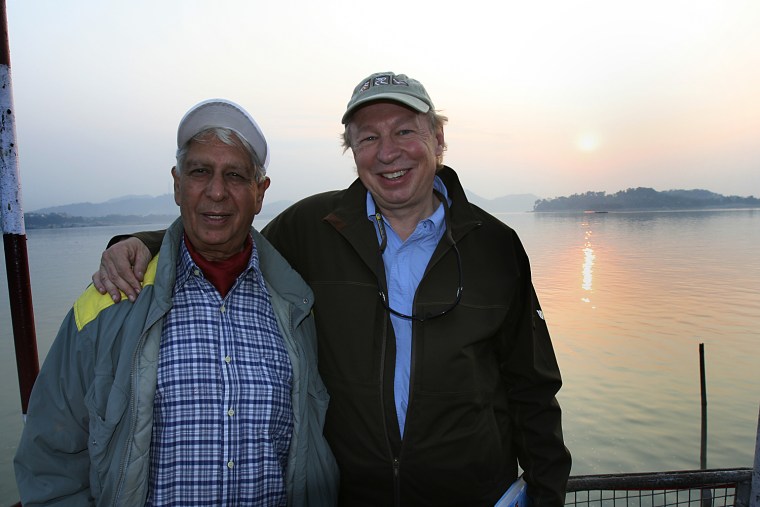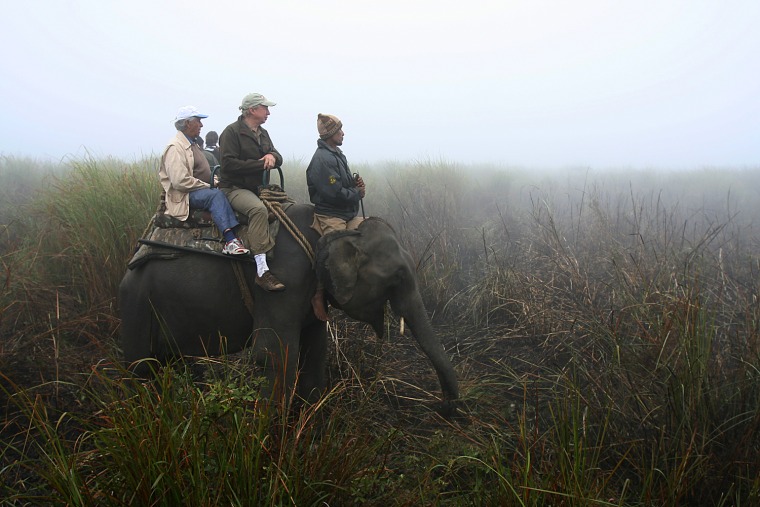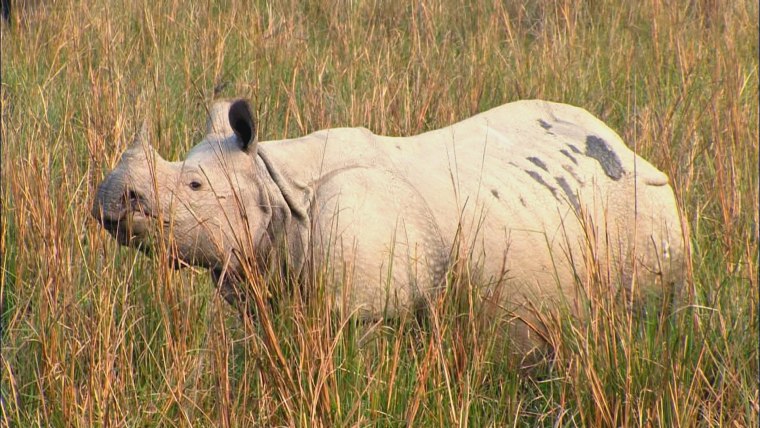“The greatness of a nation and its moral progress can be judged by the way its animals are treated” — Mahatma Gandhi
In 1981 I attended a fundraiser in Lusaka, Zambia, for something called “The Save the Rhino Trust,” along with a raft of ideologues, NGO officers, and the elite of the country. The president of the country at the time, Dr. Kenneth Kaunda, urged me to take the stage at one point and make a pledge for the cause. I had never seen a rhino in Zambia, or anywhere outside of a zoo for that matter, but I was starting to bring adventure travelers to Zambia through my company Sobek, mostly to raft the Zambezi, but some to take walking safaris.
“I promise to use all my resources to inspire travelers to come here and see the last of the rhinos so that they might be touched by their plight, and become involved in their preservation,” I swore to the audience.
But I never made good on that pledge. And when I returned to Zambia last year, all the rhino were gone.
Rhinos once roamed the earth in countless numbers. They padded across Africa, most of Asia, even Europe and North America. But now most have disappeared. Over the last 30 years I traveled all through Java, Sumatra, Borneo, China, Nepal; the length of Africa from Algeria to Zimbabwe. But I had never seen a rhino in the wild.
So, when my old friend Avinash Kohli visited me in Los Angeles a few months ago, he shared some news that inspired me to pack the bags and head to the airport. Like me, Avinash has been in the travel business his whole career, but he has specialized in private, upscale tours to the wild places of India. He had guided The Beatles, Mia Farrow, Jimmy Stewart, kings and other royalty, even Sir Edmund Hillary. But he was more excited than ever before because he had just returned from a place that was wilder than anyplace he had seen in India ... and, it harbored rhinos ... one-horned rhinos, the ones many believe spawned the unicorn myths. “There are rhinos coming out of your ears,” he said. “You have to come to Assam!”

I went to the Web, confirmed Avi’s assertion, and found Assam on the map. It spreads like a kite in the far northeast of India, across a thin isthmus of land that in the last minute of Partition negotiations in 1947 escaped becoming what is now Bangladesh. India wanted to keep it because of its oil (it now supplies half of the subcontinent’s needs); China invaded in 1963, and because of border disputes, and secessionist movements, it has been off the world tourism map for most of the last half century. During British colonial days it was known for its tea, and vast estates still sprawl. But I also saw a report that estimated that in 1905 there were fewer than 200 one-horned rhino left in Assam; another account estimated that figure at less than a dozen. Rhinos were on the precipice of extinction in Assam just a century ago; within a sniff of becoming a relic of the past.
But now, as per all the reports, there are more than 2,000 rhinos in Assam, and that number is growing. What went right in Assam? I decided to go and see. And Avinash offered to be my guide.
We arrived in the dense and pungent capital of ... over a million people call this home, and I am forever amazed that cities of this size pound and thrive with little awareness of their existence in the West. I confess, even with a lifetime in the travel business, of never having heard of the place.
We stayed at the Hotel Brahmaputra Ashok on the southern bank of the Brahmaputra River, and took a sunset cruise. The Brahmaputra begins in Tibet as the Tsangpo, flows by Lhasa, loops north, and then abruptly turns south, cutting through the Himalayas, where it has carved the deepest gorge in the world. I long lusted to float the Brahmaputra. I made first descents of several great rivers of Asia, from the Yangtze to the Indus to the Euphrates, but the one that always made me yearn was the Brahmaputra ... such a tantalizing name, wet with contour and risk. The syllables slide over and around one another like intertwined snakes. And then there are the layers of resonance of this river, managing to evoke temptation and fear at once.
So to sail its waters, even in its quiet breath after its gasp through the Himalaya, was a thrill.
But also an explanation. One of the reasons wildlife has prospered here through the ages is this prodigious river. Every year the Brahmaputra floods, bringing rich soil and nutrients from the Himalayas, replenishing vast tracks of soil, soil that grows the grass and vegetation that forever feed the wildlife.
The next day we drove north to the border with Bhutan, to a little-visited park called Manas in the foothills of the Outer Himalaya.
It was once a throne-room thick with rhino, but an insurgence movement that began in the late 80s — seeking autonomy for a tribal group called the Bodo — devastated the park.
The main reason rhinos are poached is for their horns, which many Chinese still believe is an aphrodisiac and pay exorbitant prices for, even in time of Viagra and Cialis. So, when the rebels needed hard cash to buy the artillery for their “agitation,” they shot the rhino and sold the horns to overseas buyers. The rebels won their cause, achieving semi-autonomy in 1998. But in the process they killed all the rhino in Manas.
Now, five rhino have been relocated from another park, but we never saw them. We went rafting, fishing, interviewed former “hardcore poachers” who now worked as rangers, saw wild elephant, buffalo and other game. But we saw no rhino.
On the way to Manas we stopped for an afternoon at the Barpeta Satra, which is the original monastery founded by the 15th century philosopher/saint Sri Sri Sankardeva, whose teachings are a cultural bedrock in Assam society today. We met with Bashishtha Deva Sarma, the religious leader of the Satra, who told us that Sankardeva preached that animals are sacred, and should not be harmed, and his ideas have influenced much of the behavior of his followers throughout the ages.

We next drove to a bungalow in the middle of the Adabari Tea Plantation, The Wild Mahseer Lodge, named after a man-sized fish found in the Brahmaputra and Jiabharali rivers nearby.
Its single-story main building is called a bungalow, but not like any bungalow I’ve hunkered into. Built with Burma teak, it is characterized by sweeping Victorian architecture and spacious rooms (I needed hiking boots to cross mine), it has a library and a colonial sitting room replete with enormous fire place, and G&Ts for the asking (to keep malaria at bay, of course). The lodge is surrounded by 22 acres of tea gardens, the legacy of the Balipara tea estate, established by the British Assam Tea Company sometime around 1875.
While sipping tea with Avi in a room flooded with light, the manager, Mr. Durgadar Sarcas, stops in, settled into the deep couch, and told us the lodge practices something called “naturenomics,” which is an concept to create interdependence between nature and economics. He says he employs 50 locals at the lodge, and because of their good livelihoods, they have incentives to keep the area pristine, which in turn attracts visitors.
But he also says that naturenomics traces back to the original 19th century tea estates, for which Assam is probably best known. The prosperous Brahmaputra soil made the region ideal for vast and productive tea plantations, cultivated swaths that usually surrounded or abutted areas rich with wildlife — elephant, rhino, buffalo, deer and tiger. Naturally, these estates created buffer zones for the wildlife, in a way protecting them from more destructive human encroachment. And because the tea estates employed so many local peoples — sometimes thousands in a single plantation — there was never the overwhelming pressure to hunt wildlife, as has so often been the case in other areas of the world.
From Wild Mahseer, we drove to a ferry dock, and took the boat across the Brahmaputra to Majuli Island, the largest freshwater island in South Asia, and there visited another busy Satra, packed with pilgrims and worshipers. Wandering about the grounds, talking with the devotees, I learned that the respect for wildlife has deep roots here, and throughout much of the country.
It was the first great Indian king, Ashoka the Great, who in the 3rd Century B.C., created the first laws to protect fish, game and forests. Both Hinduism and Buddhism proved to be religious shields against the rapacity of humans with invocations of compassion for all living things. The Buddha tells us “to wander alone like the rhinoceros ... renouncing violence for all living things, harming not even a one.” And Hinduism evokes the prohibition against eating cows or buffalo, and since the popular ancient belief was that the rhino was half deer, half buffalo, it was out of the Hindu food chain.
After Majuli, we worked our way over to the prize of Assam, Kaziranga National Park, Assam’s first national park, and a place that pulses with feral life. It sprawls on the southern bank of the Brahmaputra, covering more than 400 square miles.
It was here that at last we saw, from the back of an elephant, our first rhino in the mist. With its thick panels of silvery-brown skin and prominent upturned nose, it seemed like something out of a unicorn’s dream. Imagination is stronger than knowledge — myth more potent than history — and this creature was a chimera come true.
In the next days we were assaulted with a crash of sightings ... at one point I walked over a ridge and came face-to-face with a giant tank of a beast, who pawed the ground and stared me down, and then shifted into Charge. “Run!” I yelled, mostly to myself, as I turned and sped away, while two park rangers dropped to their knees and rattled their rifle bolts. Trains have been attacked by rhinos and even derailed. Despite their great bulk and stubby legs, rhinos can run faster than an Olympic sprinter.
The rhino halted, though, and stooped to graze again, and I kept my distance. This is his haunt, and I was trespassing. It is as it should be.
So, what did Assam do right? It has all the challenges of wildlife regions around the world: human population pressures, loss of habitat, skulking pollution, rampant development, poaching.
But a unique weave of elements seems to have knotted here to create a Web of protection: a plait of faith, empathy and economics.
The religion and philosophy of compassion run deep in Assam, and influence a world view of respect for all living things. And the economics of tea, as well as ecotourism, have provided incentives for wildlife conservation. The one-horned rhino stands as a symbol of our better impulses, actualized here.
Assam has had the audacity to believe in preservation and promise; the will to invest in growth that doesn’t cheat the children. The core values that underpin sustainable development — interdependence, spirituality, equity and personal responsibility — are the foundations of Assam’s success. But it will take more — it will take the emotional connections and commitments that come from first-hand encounters from visitors — just as such visitations helped stem the decline of mountain gorillas.
The one-horned rhino is a magnificent being, one in whose presence hearts beat faster. Nothing happens unless first we dream. And Assam is a dream awakened. This time I will work, as my friend Avinash, to inspire my friends and family to come and see; because by seeing, we understand; and by understanding, we shape a future that allows a continuum of awe and wonder of the natural world, and without which we cannot continue to exist.
The special, “Quest for the One-Horned World”, produced by Small World Productions and Richard Bangs, is airing now on PBS. Check local listings.
